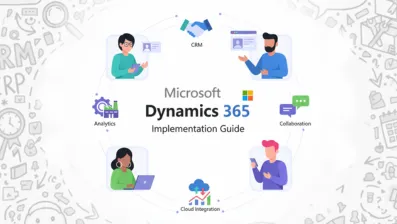Implementing Microsoft 365 sounds exciting, right?
You get powerful tools, seamless collaboration, and a modern workspace, all in one place.
But here’s the twist: it’s not always as smooth as it seems.
Many businesses dive in headfirst and soon realize that Microsoft 365 implementation challenges can be trickier than expected. You might face migration issues, compatibility concerns, or even user resistance that slows down adoption.
And that’s completely normal!
The good news? You don’t have to face these roadblocks alone. With the right plan, expert support, and a bit of guidance, you can turn every challenge into a win.
Let’s break down these common Microsoft 365 implementation challenges and see how you can overcome them with ease.
Top Microsoft Dynamics 365 Challenges and Their Solutions
Every digital transformation journey comes with its bumps, and Microsoft Dynamics 365 is no exception.
Many businesses recall the biggest challenges they faced during Microsoft Dynamics implementation, from data migration hurdles to user adoption struggles.
But the truth is, every challenge has a smart solution waiting to be applied.
Let’s get to know them all:
Challenges 1: Data Migration and Quality Issues
One of the most common Dynamics 365 implementation challenges is dealing with data — especially when you’re moving it from older systems.
Data migration can be tricky. You might face inconsistent formats, missing values, duplicate entries, or just plain outdated information. If your existing data isn’t properly cleaned before migration, it can lead to major performance issues and inaccurate insights later on.
The Solution: Before you work on Microsoft dyanamics 365 implementation, conduct a complete data audit. Clean your data, standardize formats, and remove duplicates. Use Microsoft’s built-in migration tools or third-party platforms for smoother transfers.
And here’s a pro tip — always run a small pilot migration first. This helps you catch issues early and ensure everything flows correctly when you go live.
Challenges 2: Integration Complexities
Integration is another big one. Many businesses struggle with Microsoft Dynamics 365 integration challenges when trying to connect it with existing tools like ERP systems, CRMs, or third-party apps.
If your integrations aren’t seamless, it can disrupt workflows, cause data silos, and lead to frustration among users who expect a unified experience.
The Solution: Start by mapping your integrations clearly — identify which systems need to “talk” to each other. Use Microsoft’s Power Platform connectors and APIs to simplify integration.
If you’re working with custom applications, consult experienced developers who specialize in Dynamics 365. They can help design integrations that are reliable, scalable, and secure.
Challenges 3: Lack of User Adoption
Here’s one of the biggest challenges in Microsoft Dynamics 365 implementation — getting your team on board.
You could have the most advanced system in the world, but if your employees don’t use it effectively, you’ll never see its full potential. Many users resist change simply because they don’t understand the “why” behind the new system or find it intimidating.
The Solution: Make user adoption a part of your strategy from day one. Host hands-on training sessions, create easy-to-follow guides, and explain how Dynamics 365 makes their work easier — not harder.
Encourage feedback and reward early adopters. When people see tangible benefits, they’ll embrace the platform more quickly.
Challenges 4: Customization Overload
Microsoft Dynamics 365 offers incredible flexibility — but that’s a double-edged sword.
It’s tempting to customize every little thing to match your processes. However, too much customization can lead to higher maintenance costs, longer deployment times, and upgrade headaches down the road.
The Solution: Customize with purpose. Focus only on what adds real business value.
Start with out-of-the-box features first – Dynamics 365 already has a lot to offer. Only add custom modules or features when absolutely necessary. Keep documentation updated so future teams know exactly what’s been changed and why.
Challenges 5: Poor Project Planning and Scope Creep
If your implementation plan lacks clarity, you’ll quickly feel overwhelmed. One of the most frequent Dynamics 365 challenges is scope creep, where new requirements keep sneaking in, delaying timelines and inflating Microsoft Dynamics 365 implementation costs. Without a well-defined roadmap, your project can lose focus and momentum.
Without a well-defined roadmap, your project can lose focus and momentum.
The Solution: Define your goals and deliverables before starting. Break the project into clear milestones with measurable outcomes.
Involve stakeholders early to align expectations and avoid last-minute additions. Consider working with an experienced Microsoft Dynamics 365 partner who can help you plan efficiently and manage timelines.
Challenges 6: Security and Compliance Concerns
With so much sensitive business data stored in Dynamics 365, security is always a top concern.
Many companies worry about data privacy, user access levels, and regulatory compliance, especially if they operate in industries with strict rules. These are not minor Dynamics 365 implementation challenges, but they can be handled effectively.
The Solution: Take advantage of Microsoft’s built-in security controls, such as role-based access, data encryption, and multi-factor authentication.
Conduct periodic audits and update your security policies regularly. If compliance is critical, make sure your implementation team is familiar with GDPR, HIPAA, or other relevant regulations.
Challenges 7: Inefficient Change Management
Change can be tough — especially when it affects day-to-day workflows.
Many businesses focus so much on the technical setup that they forget about the people side of things. The lack of proper change management can cause confusion, frustration, and resistance among employees.
The Solution: Communicate early and often. Keep your team informed about what’s coming, why it’s happening, and how it benefits them.
Appoint internal “change champions” who can advocate for the system and help others adapt. Regular feedback sessions also go a long way in easing the transition.
Challenges 8: Limited Technical Expertise
Let’s be real — Microsoft Dynamics 365 is a complex platform.
Without the right in-house expertise, implementation can become a long and bumpy road. Misconfigurations or incomplete setups can lead to performance issues and underutilization of the platform.
The Solution: Don’t try to do it all yourself. Partner with certified Dynamics 365 experts who’ve done this before.
They can help you navigate technical configurations, integrate tools, and ensure you’re using best practices from day one. Investing in professional guidance early often saves you time, money, and stress later.
Challenges 9: Performance and Scalability Issues
As your business grows, your Dynamics 365 setup needs to grow with it.
One of the overlooked top challenges in implementing Microsoft Dynamics 365 is performance optimization. If your system isn’t properly configured or scaled, it can become sluggish — especially with large datasets or multiple integrations.
The Solution: Monitor system performance regularly. Use Microsoft’s built-in analytics and telemetry tools to spot bottlenecks early.
Optimize data storage, streamline workflows, and clean up unused records to keep the system running efficiently. If scalability is a concern, consider moving certain workloads to the cloud for better flexibility and performance.
Challenges 10: Underestimating Post-Implementation Support
Many companies think the job is done once Dynamics 365 goes live. Unfortunately, that’s when the real work begins.
Post-launch issues, like user queries, system updates, or small bugs, can pile up quickly if you don’t have a solid support plan in place.
The Solution: Set up a dedicated post-implementation support process. Assign internal administrators or work with your Dynamics 365 partner for ongoing monitoring and maintenance.
Regular system health checks, training refreshers, and feedback reviews help keep everything running smoothly long after launch day
Challenges 11: Inadequate Training and Onboarding
Even the best systems fail if users don’t know how to use them effectively.
One of the subtle yet major Dynamics 365 challenges is insufficient training. Teams often receive a quick demo and are expected to figure things out on their own, leading to mistakes and frustration.
The Solution: Invest in proper onboarding. Offer structured training sessions that cater to different user roles, from sales to finance to support.
Use videos, FAQs, and hands-on workshops to make learning interactive. Encourage ongoing learning through Microsoft’s documentation and role-based certifications to ensure users stay confident and capable.
Challenges 12: Misalignment with Business Processes
Sometimes, the problem isn’t with the platform, it’s with how it’s set up. Businesses often rush implementation without aligning Dynamics 365 with their actual workflows, creating inefficiencies instead of solving them
This misalignment is among the biggest challenges in Microsoft Dynamics 365 implementation.
The Solution: Start with a business process review. Map your existing workflows, identify pain points, and then configure Dynamics 365 to complement them – not complicate them.
Work closely with key stakeholders to ensure the system truly fits your operations and helps teams perform better, not slower.
Challenges 13: Inconsistent Communication During Implementation
A lack of communication between departments, vendors, and project managers can create chaos.
Misunderstandings about timelines, deliverables, or system expectations often lead to rework and delays, a common pitfall in Dynamics 365 implementation challenges.
The Solution: Establish clear communication channels from the start. Schedule regular status meetings and use project management tools to track progress.
Document decisions and share updates across all stakeholders. Transparent communication keeps everyone on the same page and ensures smoother collaboration throughout the project.
Challenges 14: Difficulty in Measuring ROI
After investing time, money, and resources, you’ll want to see tangible results.
But many businesses struggle to track ROI because they lack clear performance metrics or don’t use the system’s analytics tools effectively.
This is one of the more strategic top challenges in implementing Microsoft Dynamics 365.
The Solution: Set measurable goals before implementation, such as reduced lead times, faster reporting, or higher customer satisfaction.
Leverage Dynamics 365 dashboards and Power BI integration to visualize performance data in real time. By tracking KPIs regularly, you’ll know exactly where your investment is paying off (and where to optimize further).
Challenges 15: Keeping Up with Continuous Updates
Microsoft frequently releases updates and feature enhancements to improve Dynamics 365 — which is great!
But staying on top of these changes can be overwhelming, especially when updates impact customizations or integrations. This creates new Microsoft Dynamics 365 integration challenges over time.
The Solution: Designate a team or partner to handle update management. Test all new releases in a sandbox environment before deploying them live to ensure nothing breaks.
Keep documentation updated and communicate changes to users. Regular system reviews help ensure your setup evolves smoothly with each update.
Best Practices for Secure Implementation of Microsoft Dynamics 365
Deploying Microsoft Dynamics 365 isn't all about making it go live — it's about making it go live securely, efficiently, and with strategy. By implementing proven best practices for proper implementation of Microsoft Dynamics 365, you'll sidestep the expense of costly errors, keep sensitive information safe, and achieve scalability for the long haul.
Let's discuss some of the essential practices that will enable you to gain success in Microsoft Dynamics 365 while extracting maximum value from your investment.
1. Begin with a Well-Defined Implementation Roadmap
Prior to jumping in, ensure you have a proper plan for your Microsoft Dynamics 365 implementation..
Establish your goals, timelines, and success indicators upfront. This allows you to recognize potential Dynamics 365 pitfalls before they become significant hurdles.
A good roadmap ensures that your implementation remains aligned with business and budgetary expectations.
2. Prioritize Data Security and Access Control
Data lies at the core of your business and it needs to be your first priority to safeguard it. Leverage Microsoft's built-in security capabilities such as multi-factor authentication, role-based access, and encryption.
These steps will shield your system from illegal intrusion and minimize Microsoft Dynamics 365 issues against security breaches or compliance risk.
3. Perform Regular Security Audits
Dynamics 365 implementation isn't a one-off job — it's a continuous process. Plan routine security scans to discover vulnerabilities and fix them before they become a problem. This helps keep the system intact and minimizes the long-term Microsoft 365 implementation price tag for correcting avoidable issues down the road.
4. Restrict Customization to What's Essential
Tailoring can make Dynamics 365 sound made-to-measure for your organization — but over-tailoring can lead to complications. Too many tweaks could result in performance problems or version conflicts during upgrades.
In order to steer clear of unnecessary Microsoft Dynamics 365 issues, prioritize key features and maintain your tweaks minimal and purposeful.
5. Ensure Proper User Training and Adoption
Even the best system is worthless if users do not know how to work it. Make education a central component of your plan for implementation.
Not only show your team how to work Dynamics 365, but also educate them on how to identify and avoid the most common security threats. An educated team can avoid many Dynamics 365 issues before they arise.
6. Only Integrate with Trusted Third-Party Tools
Integrations amplify the capability of Dynamics 365, but they have the potential to pose a risk if not controlled properly.
Always check the security standards of any third-party app you integrate. This simple step avoids potential Microsoft Dynamics 365 issues such as data breaches or system conflicts induced by insecure integrations.
7. Put Strong Backup and Recovery Systems in Place
No amount of caution can prevent disasters from occurring — accidental overwrites, system failure, or even cyberattacks. Having trusted backup and recovery policies ensures your data is safe and recoverable. Provide regular automated backups and test recovery processes to safeguard your business continuity.
8. Engage with Certified Microsoft Experts
It's all in the hands of certified Microsoft Dynamics 365 experts. They're intimately familiar with the platform and can assist you in building a secure, scalable, and compliant system.
And they've already navigated Microsoft Dynamics 365 pain points, so you can avoid the trial-and-error approach and get it right the first time.
How DotStark Simplifies Microsoft Dynamics 365 Implementation for You?
Implementing Microsoft Dynamics 365 doesn’t have to feel overwhelming. With DotStark’s Microsoft Dynamics 365 consulting services, you get expert guidance at every step from planning and customization to integration and post-launch support.
We understand the Dynamics 365 challenges businesses face, whether it’s data migration, user adoption, or system security. Our team works closely with you to design solutions that fit your workflows, streamline processes, and maximize ROI.
By combining technical expertise with a hands-on, personalized approach, DotStark ensures your Dynamics 365 setup is smooth, efficient, and secure. We help you avoid common pitfalls, reduce unnecessary costs, and empower your team to fully leverage the platform’s capabilities.
With DotStark by your side, you can focus on growing your business while we handle the complexities of a seamless Dynamics 365 implementation.
Conclusion
Implementing Microsoft Dynamics 365 can be a game-changer for your business, offering streamlined processes, enhanced collaboration, and actionable insights. However, it comes with its share of Dynamics 365 challenges, from data migration and integration issues to user adoption and security concerns.
By planning carefully, following best practices, and partnering with experienced professionals like DotStark, you can navigate these obstacles with confidence. A clear roadmap, proper training, secure integrations, and ongoing support ensure that your Implementation is smooth, efficient, and delivers maximum ROI.
Remember, success isn’t just about deploying the system; it’s about leveraging it effectively to empower your team and transform your business operations. With the right approach, every challenge becomes an opportunity for growth.
Frequently Asked Questions
The most common challenges include data migration issues, integration complexities, user adoption struggles, security concerns, and misalignment with existing business processes.
Careful planning, limiting unnecessary customizations, choosing the right integrations, and leveraging expert guidance can significantly minimize overall costs and resource usage.
Implementation time varies based on your business size, workflow complexity, and customization needs. Small setups may take a few weeks, while enterprise deployments can span several months.
DotStark provides end-to-end consulting, planning, customization, integration, and post-launch support, ensuring a smooth, secure, and efficient Dynamics 365 deployment.
Key practices include creating a clear roadmap, ensuring data security, conducting audits, providing user training, limiting unnecessary customization, and working with certified experts to avoid pitfalls.
.webp)



.webp)

.webp)


 +91 9680599916
+91 9680599916
 vanshika@dotstark.com
vanshika@dotstark.com
